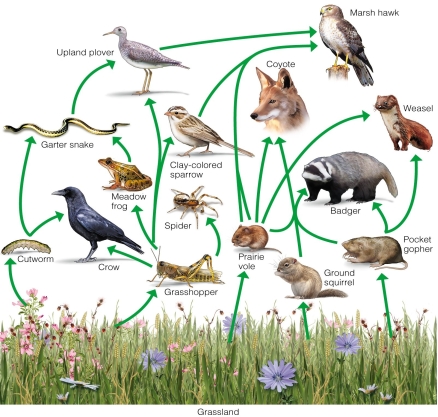Correct Answer

verified
Correct Answer
verified
Short Answer
In aquatic habitats,the upper zone of water where the availability of light supports photosynthesis by phytoplankton is called the ________ zone.
Correct Answer

verified
Correct Answer
verified
True/False
Among the array of species that make up a community,not all are equally abundant.
B) False
Correct Answer

verified
Correct Answer
verified
Short Answer
When a single or a few species are most prevalent in a community,the species are called ________.
Correct Answer

verified
Correct Answer
verified
Multiple Choice
 The garter snake in this diagram is an example of a(n)
The garter snake in this diagram is an example of a(n)
A) top predator.
B) basal species.
C) herbivore.
D) intermediate species.
F) B) and C)
Correct Answer

verified
Correct Answer
verified
Multiple Choice
Which statement best describes a keystone species?
A) a rare or uncommon species that has a strong effect on its community
B) an abundant species that may or may not affect other species
C) a species that takes up a great deal of space in a community
D) a common species that has a strong effect on its community
F) B) and D)
Correct Answer

verified
Correct Answer
verified
Multiple Choice
Dominant species tend to be more abundant than other species because they
A) prey upon or parasitize other species.
B) outcompete other species.
C) are preyed upon less than other species.
D) reproduce more rapidly than other species.
F) B) and C)
Correct Answer

verified
Correct Answer
verified
Multiple Choice
In a sandy beach community,ghost crabs and beach flies occur within
A) the supratidal zone.
B) the intertidal zone.
C) the subtidal zone.
D) any tidal zone.
F) A) and C)
Correct Answer

verified
Correct Answer
verified
True/False
Some aquatic communities are defined by physical features of the abiotic environment rather than by the dominant organisms.
B) False
Correct Answer

verified
Correct Answer
verified
Short Answer
Within a community,a group of species that carries out similar functions or exploits the same resource is called a(n)________.
Correct Answer

verified
Correct Answer
verified
Multiple Choice
An organismic concept of communities was developed by
A) Gleason.
B) Simpson.
C) Shannon.
D) Clements.
F) B) and C)
Correct Answer

verified
Correct Answer
verified
Multiple Choice
Which is the most dominant species?
A) largest in number
B) highest in relative abundance
C) most relative biomass
D) All of the above can indicate dominance.
F) All of the above
Correct Answer

verified
D
Correct Answer
verified
Multiple Choice
A species that has massive effects on an ecosystem but in proportion to its abundance is a
A) keystone species.
B) basal species.
C) dominant species.
D) top predator.
F) A) and D)
Correct Answer

verified
Correct Answer
verified
Multiple Choice
The goal of restoration ecology is to
A) create the most functional ecosystem.
B) improve productivity in an ecosystem.
C) return the community to its pre-disturbance condition.
D) restore the use of ecosystem services.
F) A) and B)
Correct Answer

verified
Correct Answer
verified
Multiple Choice
Within a food web,herbivores are considered to be
A) basal species.
B) intermediate species.
C) top predators.
D) represented at any level.
F) All of the above
Correct Answer

verified
Correct Answer
verified
Short Answer
In a forest community,the upper layer is called the ________.
Correct Answer

verified
Correct Answer
verified
True/False
Species composition does not usually differ much within a local area,such as between a hilltop and a stream bottomland.
B) False
Correct Answer

verified
Correct Answer
verified
True/False
In a well-stratified lake,the thermocline refers to a steep and rapid decline in temperature relative to the waters above and below.
B) False
Correct Answer

verified
Correct Answer
verified
Multiple Choice
Which of the following has the highest species richness? A community with
A) 34 species of high evenness.
B) 36 species with very low evenness.
C) 35 species of high evenness.
D) 33 species of low evenness.
F) A) and C)
Correct Answer

verified
B
Correct Answer
verified
Multiple Choice
Which description is true for most communities?
A) All species have approximately equal abundances.
B) All species are rare.
C) All species are common.
D) A few species are common and the remainder are rare.
F) A) and B)
Correct Answer

verified
D
Correct Answer
verified
Showing 1 - 20 of 70
Related Exams